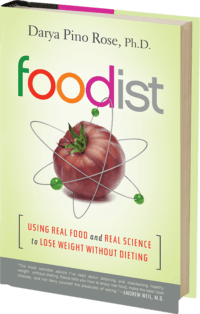The Foodist Recalibration
It’s called a recalibration. A nutritional reset that eliminates some of the most inflammatory foods that we eat for a period of 2 to 4 weeks to give your body a chance to rebalance. Once or twice a year is good.
I’ve adopted this strategy directly from Darya Rose of the Summer Tomato and her book Foodist: Using Real Food and Real Science to Lose Weight Without Dieting. I wrote a review of the book in March ’14 and still think it’s among the most simple and practical books about changing the way you eat out there.
Two weeks is sufficient. Three is better. A whole month is really great.
Will you lose weight by following this recalibration? It depends on a lot of factors but for many of us, yes. The foods you are eliminating are well-known to be inflammatory and the longer you don’t eat them, the more your body will benefit from giving them up. Will you regain the weight if you start eating all these foods in the same quantities? Yes, for sure. So, pay attention to how you feel and maybe choose to eat less of these foods in the future. Or quit eating them altogether.
While you’re taking a break from these foods, you’re going to experience a wide variety of symptoms ranging from mild headaches, funny moods, changes in your energy, changes in bathroom habits, etc. Use this time to evaluate what the impact these foods have on you.
Think about it, if eliminating these things makes you feel off, what are they doing to you when you’re eating them? Is your body craving these foods because it needs them or is it craving them because it’s addicted to them?
Below is a summary of the recalibration directly from the Summer Tomato blog. I absolutely recommend you subscribe to her blog and newsletter. In a world full of confusing nutrition advice, she’s generally a great resource. Here’s the link to the original post.
---
Summer Tomato’s Health Recalibration by Darya Rose
1. No sugar.
Everyone knows sugar is bad for you. And although I believe there’s a place for small amounts of it in a healthy diet, I’ll be living without any added sugar for the next two weeks.
If you plan on following along, I’d also recommend avoiding sugar substitutes. Calorie-free sweeteners have never been shown to assist with weight loss, and you aren’t doing yourself any favors by keeping your palate craving overly sweet foods. If you’re desperate for a little treat during this time, fruit is your best bet.
2. No wheat.
I typically limit my bread consumption to about once or twice a week, but for the next two weeks I’ll be going without it completely. Wheat is incredibly inflammatory and is associated with a huge range of health problems. Eliminating wheat and gluten, wheat’s main protein, for awhile gives your body a chance to heal from the damage done over the holiday season.
If you suspect you might be sensitive to gluten, two weeks might not be enough of a break to get you back to feeling normal. Four to eight weeks without it is what is typically recommended to test for sensitivity, so feel free to extend past two weeks if you’re troubleshooting health problems like fatigue, depression, arthritis or digestive issues.
I recommend avoiding all processed flours during recalibration, but you carbohydrate lovers still have lots of delicious options to get you through. I’ll be relying on rice, quinoa, potatoes and legumes to keep me from being a cranky low-carber. If you absolutely must eat pasta during the recalibration, there are plenty of good gluten-free options. Quinoa pastas aren’t too bad, and rice noodles are also usually gluten-free.
Keep in mind if you want to go fully gluten-free you should also skip barley. Oats don’t contain wheat gluten but are often contaminated during processing. Gluten-free oats are available at some stores.
Lastly, remember that soy sauce is made with wheat and contains gluten. A gluten-free option called tamari is an excellent substitute that basically tastes the same.
3. No dairy.
This one will be the hardest for me since cheese, yogurt and the occasional half-and-half do make regular appearances in my diet. However, dairy can make insulin regulation difficult and it can help to cut it out for a couple weeks.
Eliminating dairy products can help with other problems as well. Cow’s milk is the only food that is directly linked to acne. It can also be an inhibitor to weight loss, even in very small amounts. Like gluten, dairy can also trigger inappropriate immune responses, making it particularly problematic for people with rheumatoid arthritis, lupus, multiple sclerosis and other autoimmune diseases.
For milk lovers, I recommend almond milk or coconut milk as tasty substitutes, just be sure you get the unsweetened varieties. Here’s why I don’t usually drink soy milk.
4. Alcohol
I love me a glass of nice wine or a well-crafted artisan cocktail. I drink alcohol fairly regularly, and there is a good amount of evidence that it protects against coronary heart disease. Though there have been reports about alcohol increasing cancer incidence, the risks are typically mitigated by a healthy diet that contains plenty of folic acid.
So why do I recommend a two week break from the sauce? For starters, alcohol lowers your inhibition and makes it much harder to stick to the recalibration. It’s hard enough, you don’t need any extra excuses. The more important reason, however, is alcohol’s effect on your liver. Like fructose (the sugar molecule that is processed by the liver), alcohol promotes body fat accumulation and insulin resistance. For recalibration to be effective, you’ll need to be a teetotaler for at least two weeks. Sorry.
You might also enjoy these posts . . .









